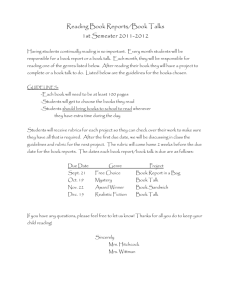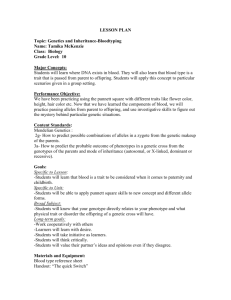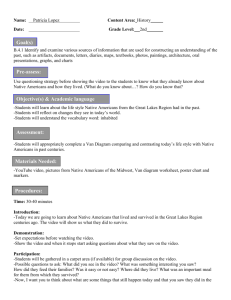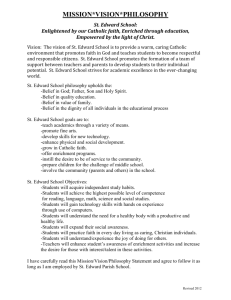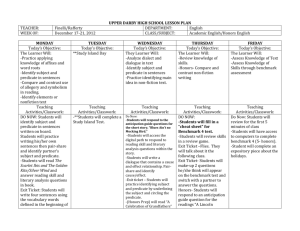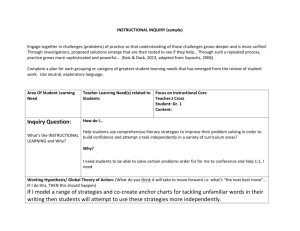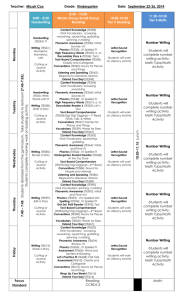File - Ms.Henninger: Teaching Portfolio
advertisement
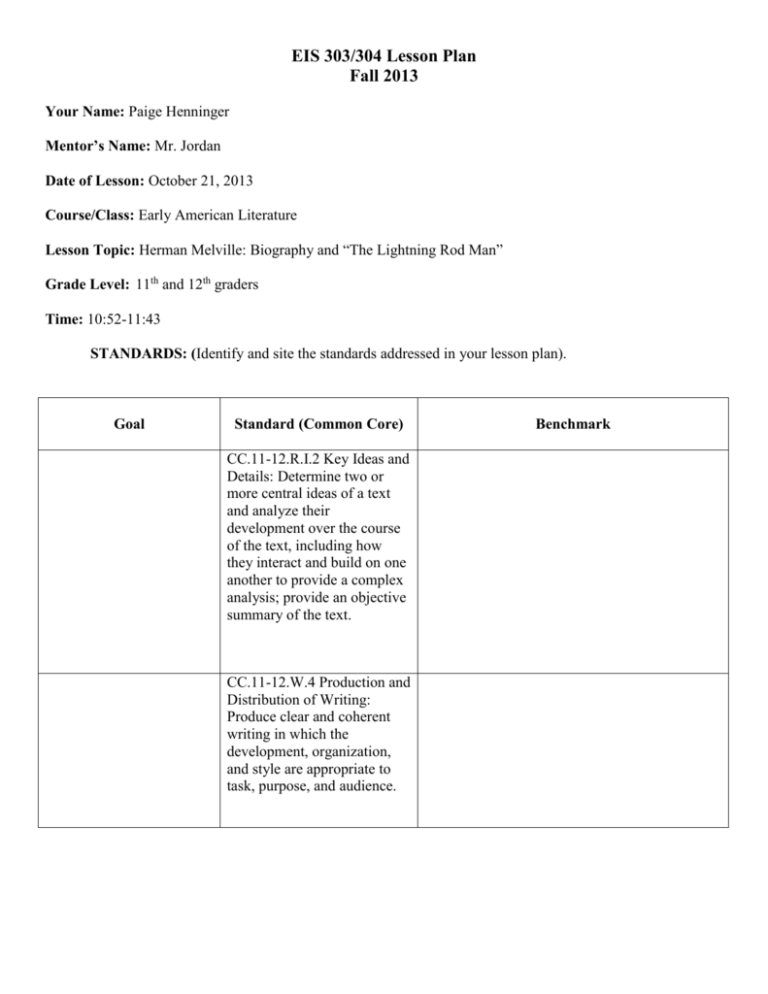
EIS 303/304 Lesson Plan Fall 2013 Your Name: Paige Henninger Mentor’s Name: Mr. Jordan Date of Lesson: October 21, 2013 Course/Class: Early American Literature Lesson Topic: Herman Melville: Biography and “The Lightning Rod Man” Grade Level: 11th and 12th graders Time: 10:52-11:43 STANDARDS: (Identify and site the standards addressed in your lesson plan). Goal Standard (Common Core) CC.11-12.R.I.2 Key Ideas and Details: Determine two or more central ideas of a text and analyze their development over the course of the text, including how they interact and build on one another to provide a complex analysis; provide an objective summary of the text. CC.11-12.W.4 Production and Distribution of Writing: Produce clear and coherent writing in which the development, organization, and style are appropriate to task, purpose, and audience. Benchmark OBJECTIVES: List your objectives, beginning with a verb that is observable and measurable. ASSESSMENT: Describe the assessment and explain its usefulness in measuring individual student learning. Attach a copy of Students will discuss the story, “The Lightning-rod Man” with their peers, and with the class as a whole. Student participation (Informal) Students will express a time in their lives where they felt pressured, just as the narrator had in “The Lightning-Rod Man”. They will demonstrate this through a journal. RATIONALE: Explain why you selected this method of assessment and its alignment with the objectives. the assessment and grading criteria. This type of informal assessment allows me to see which students seem Students will discuss with their peers to have a good understanding of the and with the whole class. They will text, and those who appear to be discuss topics such as theme, plot, or confused or not attempting to language. I will walk around as students participate with their classmates. I can are discussing and I will be able to further discuss the story if students are determine who is participating, and confused and I can move on with the understands versus those who are not activity if students appear to have a putting forth discussion. good understanding of the story. This also allows me to determine how prepared students are for the formal assessment. Journal (formal) (10 points) I choose this activity because I think a journal relates well with the text. It is Students will write a journal response to appropriate for students in the 11th and “The Lightning-rod Man”. The journal 12th grade because they are working will ask students to describe a time in on their writing skills and reading. their lives when someone was Students will be making a connection pressuring them to buy something, do from their lives to the text. This will something, or try to convince them to demonstrate relevance and apply agree with their argument. How did they “text-to-self”. Students will be handle it? Did they give in and do what applying the text to their own lives, the person wanted? Or did they make and they will be able to make valid their own decision? Students must write connections. Through their journals I in clear, complete sentences, and write will be able to see how they about a paragraph or two. understand the story, and how they make connections to their own lives. I also think that this is a valid prompt for students at this particular age because they are constantly dealing with peer pressure from others, and having to decide how they confront it. INSTRUCTIONAL MATERIALS & RESOURCES: List everything you need to teach this class. Your actual instructional materials, i.e., lecture notes, PowerPoint, maps, supplementary material, etc. must be included. Attach to your lesson plan where applicable and note where used within your lesson plan. Materials, Technology, Other Resources Needed Text book Short Story: The Lightning-rod Man” Computer Lecture Notes Projector Smart Board Journal handout IINSTRUCTIONAL STRATEGIES: Define in detail the two or more strategies you plan to use. Explain the rationale for each strategy. It should take into consideration students’ age, ability, needs, etc. Ask yourself, what is the best way to teach this lesson content to these students? Strategy or learning tasks Brainstorming/Activating Prior Knowledge Oral/Listening Based Collaboration Justification for strategy From the beginning of the lesson we will be activating students’ prior knowledge. While reading the biography, I will ask question such as: who are other authors that did not receive recognition while they were alive? What works has Hawthorn created (because Hawthorn is mentioned in Melville biography)? This will enforce students to think back to prior lessons and classes where they have discussed these issues before, and make connections. Students at this point in high school have certainly worked with authors of this time period (mid 1800s) and they should be able to make these connections that I am asking them to. Students will also be thinking critically when I ask them try to guess what the story will be about before we start reading it. This allows students to get engaged, and actually think about the possible events in the story, instead of just jumping in and having to find out gradually through the reading. This also stresses the importance that titles have for stories, they are meant to convey a part of the story, and meant to draw readers in. This activity will also get students more interested in the reading, because they will want to know if their assumptions were correct. Students will be participating in reading, and listening to myself, and their peers. Not only will we be reading the story together, but also listening to each other read. Students will respectfully listen to their peers and me. It is a good practice to read aloud in front of others because it allows students to practice reading fluency and rhythm. I will also be stopping throughout the story to make sure that vocabulary is understood, and that important parts are noted. I could not do this through independent reading, because students read at different speeds. This strategy also ensures me that everyone has read the story thoroughly and understands components of the story. This class can be very distracted, so when they have individually read in the past, I can see those who are not really reading because they are trying to check their phone, or work on other homework. This ensures that everyone will be reading together and distractions will be minimized. This particular group of students works well with each other, and enjoys working with their peers. They will be reading the last part of the story together in groups and then doing a small discussion on their reactions to the story. I will then ask students to come back together as a whole. I will ask groups to share their thoughts on the story. I would like students to state what the message/theme possibly was, parts of the story they liked/disliked, and any opinions. This allows students to determine the theme or important aspects of the story on their own without me simply telling them. If they do not understand the overall message, I will of course, push them in the right direction. This also prepares them for the assessment and allows me to informally check if they understood the text. BEFORE CLASS BEGINS: Consider what happens before you start your lesson or before the “bell” rings. What duties are you responsible for? Will you greet your students? How and where? Are there routines and procedures already in place or will you plan something? I will stand outside the classroom with Mr. Jordan and greet students as they walk in the class. When the bell rings, I will walk into the class and take attendance on the computer, and wait for students to get settled in their seats. When I finish taking attendance, I will stand in front of the class and greet students. I will then inform students about the plan for the day. Classroom procedures OPENING: * Introduce the lesson. Establish yourself as the teacher. YOU start the class! (approximate time) -Students will walk in and take their seats and prepare for the class. (1 min) -Students will get out their textbooks, and prepare to read Melville. (2 min) Instructional Details -I will be standing at the podium and I will begin class. -“Good morning students. I hope that your day is going well.” -“We just finished up The Patriot, and I hope that you all enjoyed it.” (1 minute) -To begin, I will inform students of the plan for the day. -“We will begin reading he biography of Herman Melville in the book, then we will read a short story in class together, you will do a little group work, and lastly, I will give you a journal response.” -I will ask students to get their textbooks out and turn to page 352. (2 minutes) Accommodations/Modifications: Discuss with your mentor any accommodations/modifications necessary for ALL students’ success. INSTRUCTIONAL METHODS: Provide clear and detailed instructions enabling a third party to use this lesson plan. Detail all procedures for the instructional strategies. Detail all questions for discussion, provide full examples, etc. (approximate time) -Students will listen to me read the first part of the autobiography. -Students will volunteer to read and take turns reading. -Students will ask me any questions they may have and we can discuss them together. -Students will answer any questions I may ask the class. (8 min) -Students will determine what they think the story will be about based on the title of the story. -Students will raise their hands if they have a comment to make about the title. (5 min) -We will read the autobiography of Herman Melville together as a class. -I will begin reading and then I will ask for a volunteer to read, and then they can choose another student to read. -I will stop students to pause for discussion on important parts of the biography. -Such as: talk about other authors who were not given as much recognition until after their death, Hawthorn and his works and beliefs. -We will briefly discuss the biography. (8 minutes) -Next, I will introduce the title of the short story we are going to read, which is “The Lightning-rod Man” -I will write/type “The Lightning-rod Man” on the smart board, and then I will ask students to think of what the title says the -Students will read along with me as I read story could be about. the beginning of “The Lightning-rod Man”, -So I want the students the guess what the and then they will volunteer to read after story will be about, and share it with the me. class. -Students will follow along as their peers -I will write/type their statements on the read. board. -Students will participate in class (5 minutes) discussion and ask me if they have any questions. -After students have discussed the title, -Students will get in their groups to finish then we will begin reading “The Lightningreading the story and they will discuss the rod Man”. story with their peers. -I will hand each student a copy of the -If they have any questions, they will raise short story. their hands and I will help them. -“Feel free to write on these as we go -Students may refer to the board if they are along, take notes and you may keep them.” not sure what to discuss. -I will read the first paragraph and then I (30 minutes) will ask for a volunteer again. -We will read the story together and discuss points throughout the story that may need more explaining, or interesting -Students will share their interpretation points that deserve discussion. with the class and answer any questions that I may ask them. (5-8 minutes) -Students will go back to their seats and they will work on the journal prompt for the rest of the hour. -They will fully answer the prompt and they will write in complete sentences. -Students will turn in their journals at the end of class when they are finished. (10 minutes) -The last page or so, I will ask students to get into the groups they were with for The Crucible project. They will read the last part of the story together, briefly discuss their initial reactions, what their impression of the story was, what the theme/message was of the story, and any interesting points they found. -I will display these questions on the board for students to refer to. (30 minutes) -Next, we will share interpretations together. -I will ask questions such as: “What did you think about the text?” “What do you think the overall message was of the story?” “Was there a theme?” “How would you describe the characters of the story?” (5-8 minutes) -When we have finished discussing, I will handout the journal prompts, and ask students work on them for the remaining of the hour. -The journal will ask students to describe a time in their lives when someone was pressuring them to buy something, do something, or try to convince them to agree with their argument. How did they handle it? Did they give in and do what the person wanted? Or did they make their own decision? OR a time in their life when they were trying to convince someone else to do something. -I will collect the journal for a grade. -It will be worth 10 points. (10 minutes) Accommodations/Modifications: Discuss with your mentor any accommodations/modifications necessary for ALL students’ success CLOSING: End the class. Provide opportunity for student feedback, key point summary, time for Q & A, and clear links to next -Students will turn in their journals and put their books under their desk. -Students will prepare for the bell and wait for the bell to ring. -They may leave the classroom when the bell rings. (3 minutes) -The last couple minutes of class I will ask students to finish up their journals. -I will ask the students for their journals and I will return them the next day. -As I collect the journals, I will let the students know what they will be doing the next day. lesson (find out from mentor if you will not be teaching). (approximate time) **If we do not have enough time to finish the lesson, I will explain what we will do in class the following day to finish. -I will wish them a good day, and good weekend and thank them for their cooperation and work for the day. (3 minutes) Accommodations/Modifications: Discuss with your mentor any accommodations/modifications necessary for ALL students’ success
